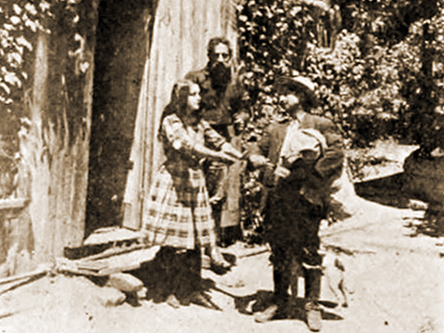| |
 |
| |
Photograph: Silent Era image collection.
|
The Hobo Cowboy
(1911) United States of America
B&W : One reel
Directed by [?] Gaston Méliès and/or Robert Goodman?
Cast: [?] Francis Ford?
G. Méliès production; distributed by The General Film Company, Incorporated. / Produced by Gaston Méliès. / Released 7 September 1911. / Standard 35mm spherical 1.33:1 format.
Drama: Western.
Synopsis: [From The Moving Picture World]? “Happy” Larry, a tramp, was taken suddenly sick, and staggered into the nearest house, wherein were seated Bill Smith and his only child, a little girl in her teens. Bill was for putting the tramp out, but the girl recognized something good in his face, and begged her father to admit him. Her word was law in Bill’s house. “Happy” soon became well under Gertrude’s ceaseless care, and when it was time to depart, Bill presented him with a suit of clothes to start life anew. He also offered him a drink of whiskey, but Gertrude was quick to obtain his promise to remain “off the stuff.” “Happy” decided to quit tramping and earn an honest living. He gained employment at a ranch as a cowboy, and it was not long before he gained popularity among them all. He took their hazing and jokes with perfect good nature and was dubbed the best sport on the ranch. One day the boys laid before him their request that he run for sheriff. “Happy” was embarrassed, but the boys held him up with revolvers and made him promise. “Happy” won out, of course, as everyone expected, and his work as sheriff was creditable. Not long after his election, however, Bill Smith had a quarrel with the saloon keeper, in which he shot and wounded the latter. A posse was formed, and. headed by the Sheriff, tracked Bill to his home. “Happy” held the boys off and himself placed handcuffs on his old friend Bill. Just then Gertrude entered and ran into her father’s arms. She turned and pleaded with “Happy.” It was too much for the latter. He could not resist the appeals of the girl who had nursed him back to life. With his revolver he made the boys put their hands up until Bill had time to cross the border. Then he threw down his gun and surrendered. Some of the boys were for lynching “Happy,” but one level-headed fellow suggested that he have a chance to tell his story. When he repeated how Bill and his daughter had saved his life and made him what lie was, the boys’ anger relented and Bill was forgiven. But this Sheriff, although once a hobo, had too much conscience to continue in office. He wrote the boys that he had not done his duty and that he guessed that after all be was made for a hobo. Donning his old clothes he slipped out unnoticed and hopped the first “freight.”
Reviews: [The Moving Picture World, 23 September 1911, page ?] A hobo is befriended by a man and his daughter. Through the influence of the girl, he becomes once more an honest man, obtains work on a ranch and ultimately runs for sheriff and is elected. Later the man who befriended him shoots the saloonkeeper. The sheriff has the handcuffs on him, but the plea of the daughter causes him to relent, and he holds up the posse with his gun until the man has a chance to get across the border. Then he surrenders. Some of the boys are for lynching him, but after hearing his story they agree with his action. He feels, however, that he has violated his oath. So he dons his hobo clothes and boards the first freight that comes along. The picture is well acted and interesting.
Survival status: (unknown)
Current rights holder: Public domain [USA].
Listing updated: 26 May 2024.
References: Thompson-Star p. 230 : ClasIm-226 p. 55 : Website-IMDb.
|




































